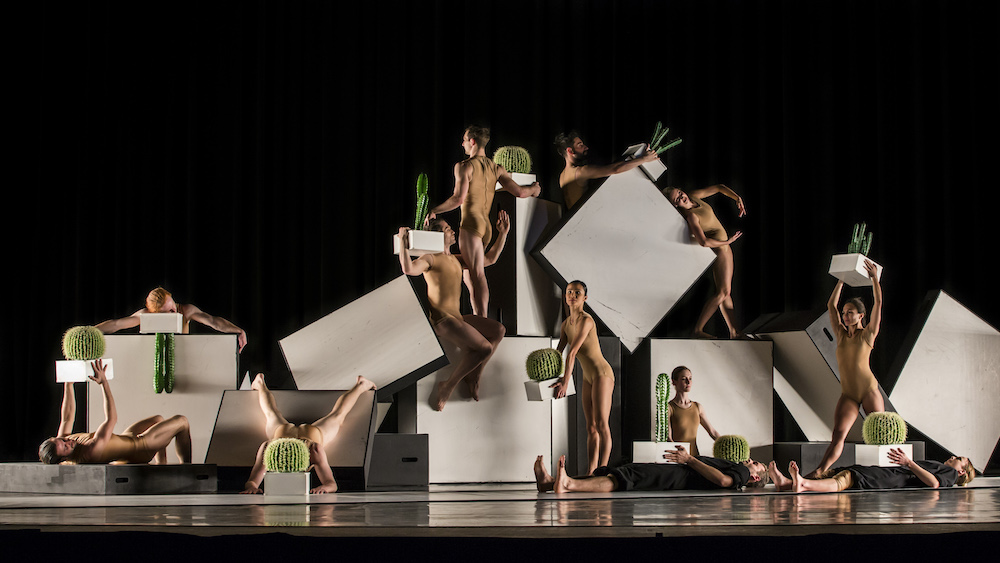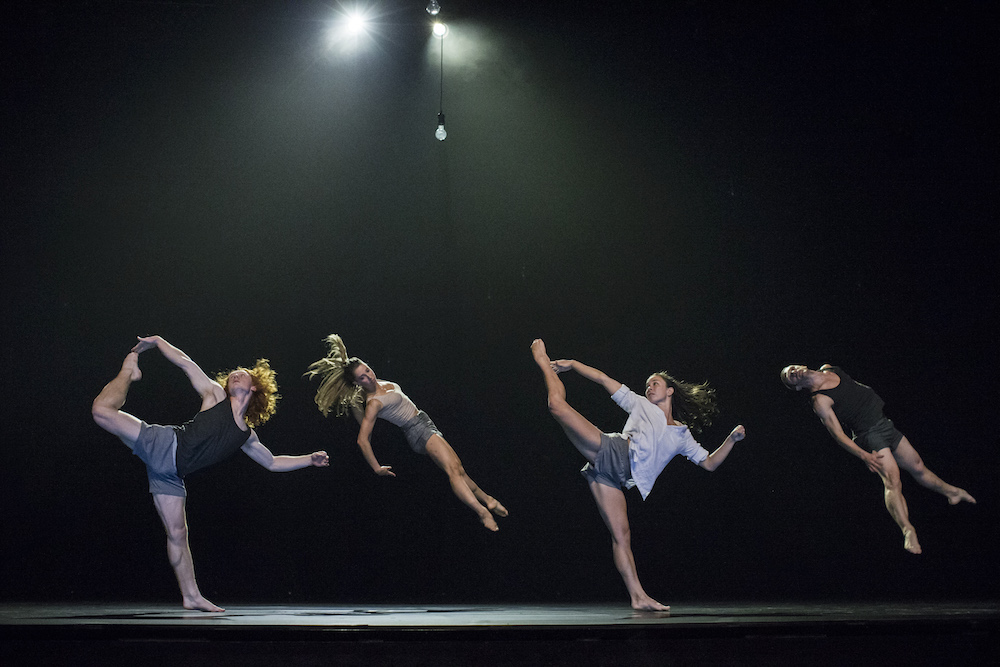★★★★½ Bonachela’s Lux Tenebris proves the perfect foil for Ekman’s Cacti.
Roslyn Packer Theatre, Walsh Bay, Sydney
February 29, 2016
It was a stellar 2015 for Rafael Bonachela and Sydney Dance Company, packed with new work, (including Bonachela’s own inventive Frame of Mind) which saw them winning awards and garnering praise left, right and centre. For SDC’s new double bill, aptly called CounterMove, they look set to remain firmly on course with a winning combination that, on the one hand provokes and entertains, and on the other confronts and moves its audience in a dazzling evening of dance.
In a double bill of old(ish) versus new, light versus dark, classic versus contemporary, Alexander Ekman’s Cacti is the known quantity. Created in 2010 for Nederlands Dans Theater, it has been in SDC’s repertoire for a few years now and, with its prickles as sharp as ever, shows no signs of losing its appeal. On the surface, a witty lampooning of contemporary dance criticism and our need to understand and explain the abstract, it takes aim at the pretensions of ‘those in the know’ – or more importantly, ‘those who pretend to be in the know’.
The brilliantly fragmented score is made up of bits and pieces of Haydn, Beethoven and Schubert, some of which are played live by a fine onstage string quartet which is called upon to enter the action at times. The mash-up veers from mad minimalist riffs to something like the soundtrack to a Spaghetti Western – always high-octane and always engaging. The SDC dancers begin like artisans at work, rhythmically doing, making, tutting at each other and beating out the occasional tattoo on their individual rostra. Like Michelangelo, they strive for the individual, yet seem condemned to repeat the group dynamic. The execution of the choreography is astonishingly tight throughout, their moves as angular as mortises. In fact it’s as sharp and precise as the cacti they proceed to collect and display like exhibits in some kind of living art gallery.

Why are cacti funny? Perhaps it’s the incongruity, perhaps it’s the way they are held, perhaps they just are, but any which way, as a supercilious voice-over teases us with hifalutin meanings for what we are watching, it’s genuinely laugh out loud – and not many contemporary dance shows can make that claim. The protagonists veer from self-important statuary to hysterical mockers of modernity. There’s a crazy tarantella with moments of vaudeville clowning, some clever partner work, and a hysterical duet where the sometimes arbitrary meanings behind certain moves and sequences is brilliantly sent up to the sky by Charmene Yap and Bernhard Knauer. There’s even a clever final sequence where the voice-over ums and ahs, dithering about what moment to end the piece on – and which dance maker hasn’t agonised over that?
In almost complete contrast, CounterMove offers Rafael Bonachela’s new work, Lux Tenebris (Light in Darkness) as a counterweight to all that fun and frivolity. In what is a substantial new work, the SDC Artistic Director explores ideas of memory and the physical effects of illumination and blackness in our lives. It’s a true collaboration as well, since Bonachela chose to work intimately in the studio with composer Nick Wales on the visceral industrial-meets-electronica score, fine-tuning the music before exposing the dancers and drawing on their initial responses in order to craft the finished work. The result is a powerful score, which while never overloud, fuels the dance and manages to be suitably threatening, even oppressive at times, while Bonachela responds with choreography that considers and complements each and every beat. Benjamin Cisterne’s evocative lighting is the third element in the collaboration, creating a playing space able to transform atmospherically from day to night at the flick of a switch.

At the risk of appearing guilty of the very thing Ekman has so wittily skewered in the first half, I admit that Bonachela’s piece seemed to tap into this writer’s childhood memories; of growing up on the fringe of a town where beyond the street lamps of a modern housing estate could be glimpsed a tantalising darkness where it seemed anything might be possible. An aspect of danger and allure infuse Bonachela’s visual snapshots of people half glimpsed, part way though an activity, and where the unseen, or the yet to happen, is as important and emotive as what is seen to be playing out in the light.
When fully illuminated, the dance can be wild, involving complex group dynamics, with bodies hurtling across the stage at floor level and dancers flickering with the musical snap, crackle and pop. At times it’s like watching the choreographic equivalent of REM, a gift for SDC’s razor-sharp, disciplined dancers. Contact levels are high (also in contrast to Ekman’s work), giving the piece a frequently sensual edge. The flip side of the ensemble complexity is revealed in some intense solos and duets where single figures are isolated, alone and tortured in the night. Front-lit, back-lit, top-lit, it’s exciting stuff and builds to a clubby, candlelit sequence of breathtaking beauty before fracturing into images of loss, loneliness and isolation.
With SDC’s world-class dancers and perfectly contrasting halves, CounterMove has something for everyone, and can be recommended as one of the current best nights out in town. But more than mere entertainment, with the pointed curiosity of Cacti and the brooding eloquence of Lux Tenebris, this is contemporary dance that asks big questions – and that’s more than just art, right?











Comments
Log in to join the conversation.